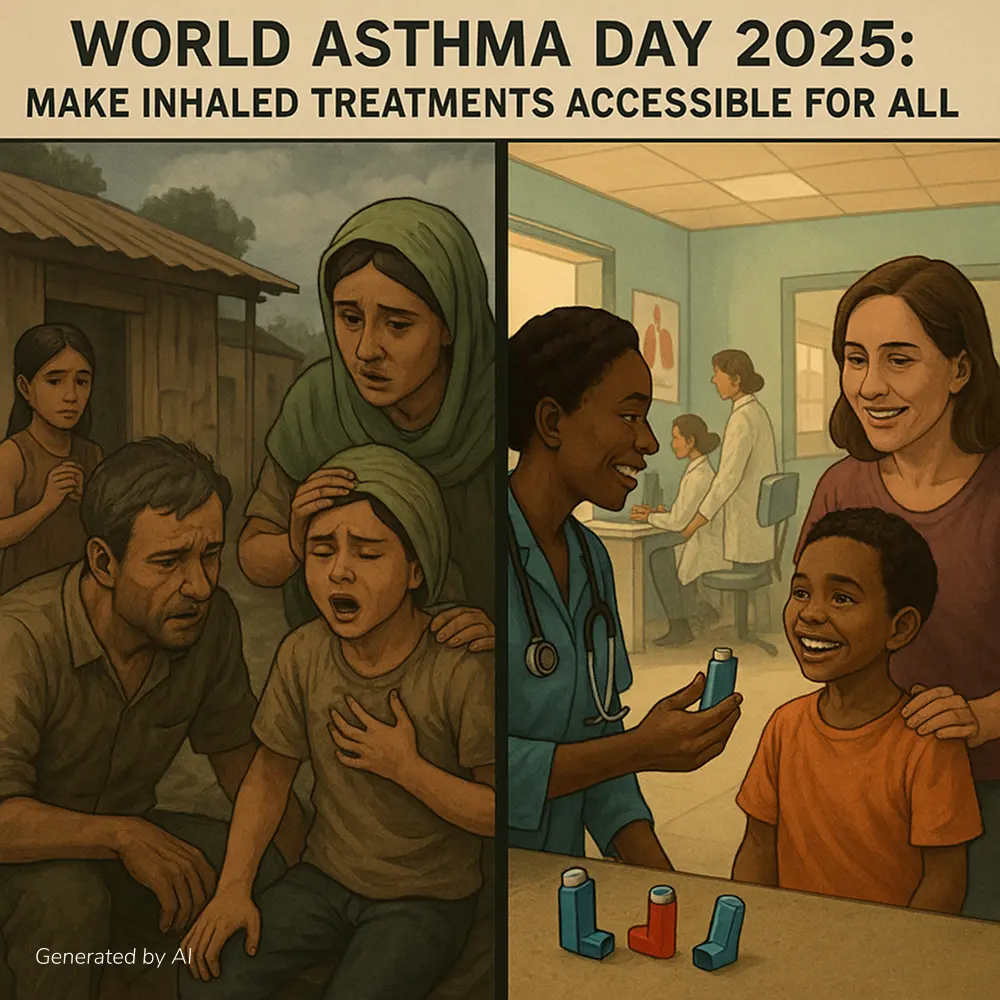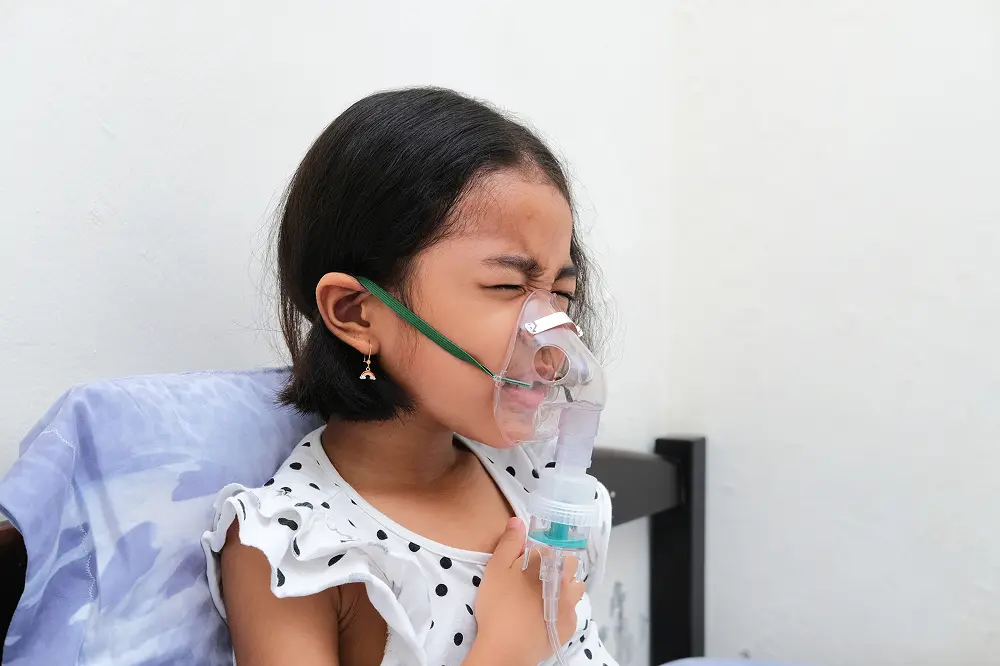May 6, 2025, is World Asthma Day 2025—a global day to help people learn more about asthma, a long-term lung disease that affects millions of people.
This year’s theme is “Make Inhaled Treatments Accessible for ALL.” It focuses on the need to make asthma medicine easier for everyone to get, especially since air pollution is making asthma worse. Asthma makes it hard to breathe because the airways in the lungs get swollen, tight, or blocked. According to the 2019, about 262 million people had asthma, and over 450,000 people died from it.
is especially serious in low- and middle-income countries, where many people don’t know they have it or can’t get the right treatment. This leads to more severe illness and more deaths. Besides, these countries also have high air pollution levels that worsen the asthma conditions.
What is The Role of Air Pollution in Asthma?
Asthma can run in families, but it’s not just about genetics. Environmental factors—especially air pollution—also play a big role in causing asthma and making it worse.
Air pollution includes harmful substances like:
- PM2.5 (very tiny particles)
- PM10 (slightly larger particles)
- Nitrogen dioxide (NO₂)
- Ground-level ozone
These pollutants can irritate and inflame the lungs, which can trigger asthma symptoms and even lead to serious asthma attacks.
Studies back this up. A 2020 study in Denmark, published in T, checked the data of children born between 1997 and 2014. Thus, it found that more exposure to PM2.5, PM10, and NO₂ increased the risk of asthma and long-term wheezing. As just a small increase in pollution levels can even raised the risk:
- PM2.5: 5% higher risk
- PM10: 4% higher risk
- NO₂: 4% higher risk
This shows a clear link between higher pollution and more asthma, especially in kids.
A 2025 study in Nanjing, China, published in , also found that higher air pollution levels led to more hospital visits for asthma in children. The study pointed out that things like gender, age, and season may also affect how pollution impacts asthma, and more research is needed.
What is the Global Impact of Asthma and the Need for Clean Air on World Asthma Day 2025?
Asthma is a major global health issue. According to the World Health Organization (WHO), there were 262 million cases and more than 450,000 deaths from asthma in 2019.

The Global Asthma Report 2024 shows that India alone makes up over 15% of the world’s asthma deaths. Because one big reason is air pollution in cities—especially from PM2.5 (tiny particles), vehicle fumes, and factory emissions.
Dr. Abha Mahashur, a lung specialist in Mumbai, points out that children are more at risk because their lungs are still developing and they spend more time outdoors. As a result, more kids in polluted cities are getting asthma.
In the United States, the American Lung Association’s 2025 report found that about 156 million Americans live in areas with unhealthy air—either from soot (PM2.5) or smog (ozone). Hence, these pollutants can trigger asthma attacks and make symptoms worse. They’re also linked to more hospital visits, early deaths, and a higher risk of heart attacks and strokes. Children and older adults are especially at risk.
In Europe, the European Environment Agency (EEA) said in 2025 that most people in cities breathe air that doesn’t meet WHO safety standards. In 2022 alone, this led to:
- 239,000 early deaths from fine particles (PM2.5)
- 70,000 deaths from ozone
- 48,000 deaths from nitrogen dioxide (NO₂)
This makes air pollution Europe’s biggest environmental health threat, and a serious challenge for asthma care.
The State of Global Air 2024 report gives a full look at air quality and health in over 200 countries, using data from 1990 to 2021. It shows clear links between air pollution and asthma around the world.
Comparing Asthma Around the World
The table below shows how asthma and air pollution affect different parts of the world:
| Region | Asthma Cases (Millions) | Annual Deaths | Air Pollution Impact | Key Fact |
| Global | 262 | 450,000 | High | 15% of asthma deaths happen in India |
| United States | ~25 | ~3,500 | Significant | 156 million people live in areas with dirty air |
| Europe | ~30 | ~357,000 | Major risk | 239,000 deaths from PM2.5 in 2022 |
| India | ~37 | ~67,500 | Critical | Sharp rise in asthma among city children |
This comparison shows how asthma is a global issue, but some areas are hit harder than others—especially places with more air pollution and less access to healthcare. Local solutions are needed to match each region’s challenges.
How Does Air Pollution Affect Children and Vulnerable Groups?
Children are especially sensitive to air pollution, which makes their asthma worse or even causes it in the first place. This is because their lungs are still growing, and they breathe more air relative to their body size than adults do.

According to the Harvard T.H. Chan School of Public Health, about 1 in 10 children in the U.S. have asthma. Breathing polluted air—from cars, power plants, and wildfires—makes their risk of asthma attacks much higher. A 2023 EPA report also warns that climate change and rising temperatures will lead to more asthma in children in the future.
A 2022 study in The Lancet Planetary Health found that air pollution can trigger asthma attacks in children and teens, even when viruses aren’t involved. The study showed that air pollution can cause specific types of inflammation in the airways, which helps explain how it affects asthma and could lead to better ways to prevent and manage it.
What Actions Can Make World Asthma Day 2025 More Effective?
To reduce asthma caused or worsened by air pollution, action is needed from governments, communities, and individuals.
Governments can help by:
- Making stricter rules to limit pollution
- Supporting clean energy like wind and solar
- Checking air quality more often and more accurately
The World Health Organization (WHO) says that more countries are now using air quality standards, 17% more than before, which is a good step forward.
Communities can help by:
- Holding asthma check-up events
- Pushing for asthma-safe environments in schools and workplaces
Tools like the Awareness Days Events Calendar help communities plan these efforts.
You can help by:
- Taking buses, trains, or bikes instead of cars
- Supporting clean air programs
- Staying indoors on days when the air is very polluted
This year’s theme, “Make Inhaled Treatments Accessible for ALL,” reminds us how important it is to make asthma medicines easy to get and affordable. This includes inhalers that help prevent asthma attacks, which are especially needed in low-income areas, as pointed out by the (GINA).
Final Thoughts: What’s Next?
We now know that air pollution and asthma are closely linked, affecting millions of people every year.
World Asthma Day 2025 is a powerful reminder to:
- Clean up the air
- Make asthma treatment easier to get
- Focus on helping those most at risk—like children
Looking ahead, scientists will continue studying asthma trends using new research tools (like the Bayesian models used in the GBD Asthma Analysis) to better predict and plan for the future.
By working together—through stronger policies, community efforts, and smart personal choices—we can help reduce asthma and create a healthier future for everyone.